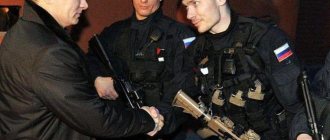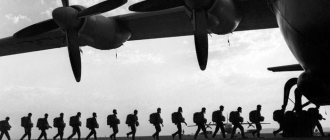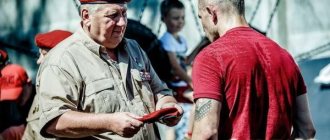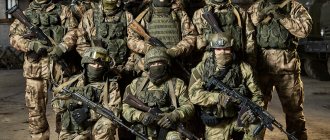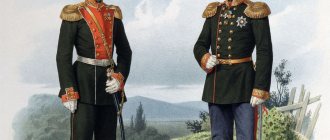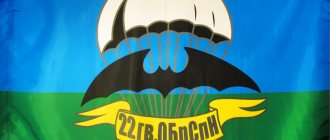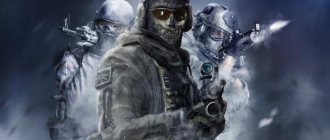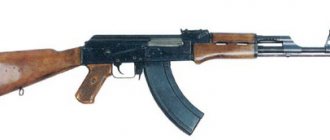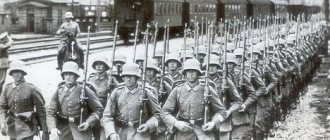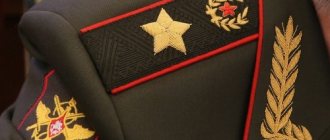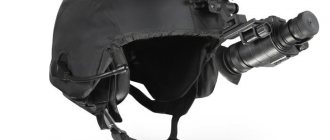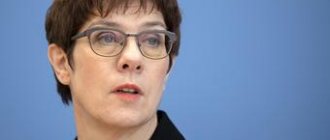The US Army Special Forces Command (SSF) was officially established on November 27, 1990. According to the Pentagon leadership, military personnel of the Special Forces Forces of the Army - the Green Berets - are the most prepared and trained contingent, which is the elite of the American army.
When it comes to the special forces of the US ground forces, it is the “Green Berets” that come to mind, which everyone who has watched the movie “Rambo” knows about. These are elite units of the American army, created for guerrilla warfare and special operations. Their motto is “De Oppresso Liber,” which is Latin for “Liberate the Oppressed” (or “For the Freedom of the Oppressed”). The specialization of this unit is often confused by many with the “Navy Seals” or Rangers.
The main task of the Green Berets is to penetrate enemy-occupied territories and conduct a covert fight. They often collaborate with local guerrilla movements. The Green Berets' ability to move unnoticed and blend into the terrain allows them to be used for swift attacks on key enemy positions.
The Green Berets were the main unit in a number of highly classified US government operations during local conflicts and counter-terrorism operations. The unit is headquartered at Fort Bragg, North Carolina. In addition, the Green Berets are assigned “night stalkers” (160th Special Forces Helicopter Detachment), which provide air support.
The first Green Berets were a volunteer American-Canadian brigade created in 1942 and trained in covert tactics. Later its fighters received the name “Devil's Brigade”. Similar tasks were performed by both Merrill's Marauders (Colonel Frank Merrill's detachment) and the Alamo Scouts (Walter Krueger's detachment). In its modern form, the unit was formed in 1952, this was connected with the theory of the future President John Kennedy, who believed that the emphasis should be on creating forces capable of waging guerrilla and counter-guerrilla warfare in various regions of the earth.
It was his idea to take the green beret as the unit’s distinctive insignia. In a special memorandum, this headdress was called “a symbol of superiority, a sign of courage, a distinctive mark in the struggle for freedom.”
Each group of Green Berets is designed to perform operations in a specific theater of military operations (TVD).
The key element is the "A" team. It consists of twelve people, usually consisting of two officers, two demolitions, two weapons specialists, two snipers, two radio operators and two orderlies. All team members have experience in parachute jumping, are able to make long marches, hide behind enemy lines for months, and speak several foreign languages typical for theater operations.
These special forces have visited almost every part of the globe. On the Internet you can see photographs of Green Berets patrolling the mountainous regions of Afghanistan on horseback. They carried out reconnaissance and sabotage missions during the wars in Korea and Vietnam, and participated in operations in Kuwait and Iraq.
Green Berets can perform tasks in:
- Defense of foreign powers;
- Unconventional warfare;
- Special intelligence;
- Counter-terrorism activities.
Candidates for Green Berets can be any American military personnel who have parachuting experience. However, in order to join this special unit, applicants will need to pass several qualifying competitions.
This stage of verification consists of a three-week assessment and selection course, which in turn includes three phases. During this time, candidates are completely cut off from the outside world.
Second phase
Testing endurance and physical strength. Candidates overcome an obstacle course, perform forced marches in uniform, perform cross-country runs, and swim in uniform with shoes. The ability to navigate terrain and work under stressful conditions is tested daily and nightly, and various psychological tests are conducted.
How to determine the types of berets of law enforcement units by color in the Russian Federation
Currently, almost every branch of the military has its own color for this item. The following colors are available:
- Black - Marine Corps;
- Blue - airborne troops;
- Light green - border troops;
- Green - reconnaissance;
- Olive - Russian Guard;
- Gray - Ministry of Internal Affairs;
- Orange - Ministry of Emergency Situations.
Another type of color is the maroon beret. It is the hallmark of the elite special forces. Unlike other options, the right to wear it must be earned. And this can be achieved in two ways.
The first is to pass difficult qualification tests, which are held in September. They are admitted to military personnel who have served in special forces for at least six months.
The second is to receive it as a reward for perseverance and courage shown in real combat.
But having received this award, you need to live up to it. There are a number of offenses for which a serviceman may be deprived of the right to wear a maroon beret.
It is also worth knowing that this distinctive sign does not provide any advantages or benefits . This is a symbol of perseverance and courage, as well as selfless service to one’s homeland.
Third phase
Assess candidates' leadership qualities, as well as their collective action skills. Candidates are appointed squad commanders, after which their military skills and knowledge are tested, as well as their ability to rally personnel to perform assigned tasks. The completion of the tests is monitored by an independent commission, senior officers and sergeants. In fact, they determine the level of readiness of candidates. After the third phase, half of those interested are eliminated.
Those who have already passed the first stage of selection will participate in the second qualification course, which also consists of three phases.
What can the color of a beret mean?
Not many people probably wonder what this or that color of a military man’s headdress means. Of course, not every color has a hidden meaning, but some options have it.
- The maroon beret is painted red. It symbolizes the blood of warriors shed in battles for the homeland. And this variation got its name from the name of the plant from which the dye of this shade was produced.
- Blue tint The headdress of the airborne troops symbolizes the heavenly expanses. It’s not for nothing that paratroopers are called “sons of heaven.”
Attention! Initially, in 1967, the Airborne Forces beret was crimson, but then in 1969, the creator of this group of troops, V.F. Margelov decided that blue was more consistent with this direction.
- The green color of the border guards' headdress is due to the fact that this color is the priority color of this group of troops.
- The same explains the color of the beret of the Marines and the Ministry of Internal Affairs.
- The bright colors of the headdress of the Ministry of Emergency Situations are dictated by generally accepted standards for the color scheme of this type of service in the world community.
Second phase
Studying special disciplines in a chosen or recommended specialization. At Fort Bragg, the training process can last 13-45 weeks. All candidates are given in-depth training in weapons, engineering, medical training, and communications. Officers and warrant officers are trained separately. Studying is replaced by constant forced marches, with tactical and topographical exercises.
Among the main military specialties, candidates master:
- Tactics, anti-tank weapons systems, all small arms of many countries, shooting, MANPADS, fire systems, fire control in combined arms combat - this applies to weapons specialists;
- Construction training, construction of field shelters, demolition work - this applies to specialists in engineering training;
- Traumatology and surgery - this applies to medical specialists;
- All communication systems and communication theory, practice in establishing and maintaining communications even on a global scale - this applies to communications specialists.
Organizational structure of the Green Berets
The Special Operations Command is subordinate to the US Army Special Operations Command, headquartered at Fort Bragg, and they command all Special Forces groups. This is neither more nor less: the 75th Ranger Regiment with special operations air units, special operations support units, civil administration and psychological operations units, with a center and school of special methods for waging wars named after J. Kennedy.
The commander of the special operations forces is subordinate to fully deployed special forces groups of five units. He also carries out general management in the training of two special forces groups of the National Guard.
History and types of military berets (60 photos)
In many armies of the world, berets indicate that the units using them belong to the elite troops. Let us consider their history and varieties among different types of troops.
Given the practicality of the beret, its informal use by the European military dates back thousands of years. An example is the blue beret, which became a symbol of the Scottish military in the 16th and 17th centuries. As an official military headdress, the beret began to be used during the War of Succession to the Spanish Crown in 1830 by order of General Tomás de Zumalacárregui, who wanted an inexpensive way to make headdresses resistant to the vagaries of weather in the mountains, easy to care for and for use on special occasions .
Other countries followed suit with the creation of the French Alpine Chasseurs in the early 1880s. These mountain troops wore clothing that included several features that were innovative for the time. Including large berets, which have survived to this day.
Berets have features that make them very attractive to the military: they are cheap, can be made in a wide range of colors, can be rolled up and tucked into a pocket or under shoulder straps, and can be worn with headphones (this is one of the reasons why tankers adopted the beret) . The beret was found particularly useful by armored vehicle crews, and the British Tank Corps (later the Royal Tank Corps) adopted this headgear as early as 1918.
After World War 1, when the issue of official changes to the uniform was considered at a high level, General Elles, who was a propagandist of berets, made another argument - during maneuvers, a beret is comfortable to sleep in and can be used as a balaclava. After lengthy debate within the Ministry of Defence, the black beret was officially approved by His Majesty's decree of March 5, 1924. The black beret remained the exclusive privilege of the Royal Tank Corps for quite a long time. Then the practicality of this headdress was noticed by others and by 1940 all armored units in Great Britain began to wear black berets.
German tank crews in the late 1930s also adopted the beret with the addition of a padded helmet inside. Black has become a popular color for tank crew hats because it doesn't show oil stains.
The Second World War gave berets new popularity. English and American saboteurs, who were thrown behind the German lines, in particular to France, quickly appreciated the convenience of berets, especially dark colors - it was convenient to hide their hair under them, they protected their heads from the cold, the beret was used as a balaclava, etc. Some British units introduced berets as the headdress of formations and branches of the military. So, for example, it happened with the SAS - Special Aviation Service, a special purpose unit engaged in sabotage and reconnaissance behind enemy lines - they took a sand-colored beret (it symbolized the desert, where the SAS had to work hard against Rommel’s army). British paratroopers chose a crimson beret - according to legend, this color was suggested by the writer Daphne Du Maurier, the wife of General Frederick Brown, one of the heroes of the Second World War. Because of the color of the beret, the paratroopers immediately received the nickname “cherries.” Since then, the crimson beret has become an unofficial symbol of military paratroopers around the world.
The first use of berets by the US military dates back to 1943. The 509th Parachute Regiment received crimson berets from their English colleagues as a sign of recognition and respect. The use of the beret as a headdress for military personnel in the Soviet Union dates back to 1936. According to the order of the USSR NGOs, female military personnel and students of military academies were required to wear dark blue berets as part of the summer uniform.
Berets became the default military headdress in the late 20th and early 21st centuries, just as the cocked hat, shako, cap, cap, and cap did in their respective eras. Berets are now worn by many military personnel in most countries around the world.
And now, actually, about berets in elite troops. And we will start, of course, with the Alpine rangers - the unit that introduced the fashion for wearing berets in the army. Alpine Chasseurs (Mountain Riflemen) are the elite mountain infantry of the French Army. They are trained to conduct combat operations in mountainous and urban areas. They wear a wide dark blue beret.
The French Foreign Legion wears light green berets.
French Navy commandos wear the green beret.
The French Marines wear dark blue berets.
French Air Force commandos wear dark blue berets.
French paratroopers wear red berets.
German airborne troops wear maroon berets.
German special forces (KSK) wear berets of the same color, but with a different emblem.
The Vatican Swiss Guards wear a large black beret.
The Dutch Royal Marines wear dark blue berets.
. The Airmobile Brigade (11 Luchtmobiele Brigade) of the Royal Netherlands Armed Forces wears maroon berets.
The Finnish Marines wear green berets.
Italian paratroopers of the Carabinieri regiment wear red berets.
Soldiers of the special unit of the Italian Navy wear green berets.
The Portuguese Marines wear dark blue berets.
Soldiers of the British Parachute Regiment wear maroon berets.
Soldiers of the British Parachute Regiment wear maroon berets.
Special Air Service (SAS) commandos have worn tan berets since World War II.
The British Royal Marines wear green berets.
The Fusiliers of Her Majesty's Gurkha Brigade wear green berets.
Canadian paratroopers wear maroon berets.
The 2nd Australian Army Commando Regiment wears green berets
American Rangers wear a beige beret (tan).
The American Green Berets (United States Army Special Forces) naturally wear green berets, which were approved for them in 1961 by President John F. Kennedy.
US Airborne troops wear maroon berets, which they received in 1943 from their British counterparts and allies.
US Airborne troops wear maroon berets, which they received in 1943 from their British counterparts and allies.
But the United States Marine Corps (USMC) does not wear berets. In 1951, the Marine Corps introduced several types of berets, green and blue, but they were rejected by tough warriors due to the fact that they looked “too feminine.”
South Korean Marines wear green berets.
Georgian Army Special Forces wear maroon (Maroon) berets.
Serbian special forces soldiers wear black berets.
The air assault brigade of the Armed Forces of the Republic of Tajikistan wears blue berets.
Hugo Chavez wears the red beret of the Venezuelan Parachute Brigade.
Let's move on to the valiant elite troops of Russia and our Slavic brothers.
Our response to the appearance in the armies of NATO countries of units that wore berets, in particular units of the US Special Forces, whose uniform headdress was a green beret, was Order of the USSR Minister of Defense of November 5, 1963 No. 248. According to the order, a new field uniform is being introduced for special forces units of the USSR Marine Corps. This uniform was accompanied by a black beret, made of cotton fabric for conscript sailors and sergeants and woolen fabric for officers.
. The cockades and stripes on the berets of the Marine Corps changed many times: replacing the red star on the berets of sailors and sergeants with a black oval-shaped emblem with a red star and a bright yellow border, and later, in 1988, by order of the USSR Minister of Defense No. 250 of March 4, the oval emblem was replaced by an asterisk bordered by a wreath. There were also many innovations in the Russian army, and now it looks like this. After the approval of a new uniform for marine units, berets also appeared in the airborne troops. In June 1967, Colonel General V.F. Margelov, then commander of the Airborne Forces, approved sketches of a new uniform for the airborne troops. The designer of the sketches was the artist A. B. Zhuk, known as the author of many books on small arms and as the author of illustrations of the SVE (Soviet Military Encyclopedia). It was A.B. Zhuk who proposed the crimson color of the beret for paratroopers. A crimson beret was at that time all over the world an attribute of belonging to the airborne troops, and V.F. Margelov approved the wearing of a crimson beret by airborne troops during parades in Moscow. On the right side of the beret was sewn a small blue triangular flag with the emblem of the airborne troops. On the berets of sergeants and soldiers, there was a star framed by a wreath of ears of corn on the front; on the berets of officers, instead of a star, a cockade was attached.
During the November 1967 parade, the paratroopers were dressed in new uniforms and crimson berets. However, at the very beginning of 1968, instead of crimson berets, paratroopers began to wear blue berets. According to the military leadership, the color of the blue sky is more suitable for airborne troops, and by order No. 191 of the USSR Minister of Defense dated July 26, 1969, a blue beret was approved as a ceremonial headdress for the Airborne Forces. Unlike the crimson beret, on which the flag sewn on the right side was blue, on the blue beret the flag became red.
And a modern, Russian version.
GRU special forces soldiers wear airborne uniforms and, accordingly, blue berets.
Special forces units of the internal troops of the Russian Ministry of Internal Affairs wear a maroon (dark red) beret.
But unlike other branches of the military, such as marines or paratroopers, among the special forces of the Ministry of Internal Affairs, the maroon beret is a qualification mark and is awarded to the soldier only after he has undergone special training and proven his right to wear a maroon beret.
Until they receive a maroon beret, special forces soldiers wear a khaki-colored beret
Internal Troops reconnaissance soldiers wear a green beret. The right to wear this beret must also be earned, just like the right to wear a maroon beret. Our Ukrainian brothers are also heirs of the USSR, and therefore retained the beret colors previously used in this country for their elite units.
The Ukrainian Marine Corps wears black berets.
Ukrainian airmobile troops wear a blue beret.
. Belarusian brothers also wear a blue beret in the Airborne Forces.
What types of berets are there?
Are common
- Light green - border troops. They were introduced as an element of everyday and dress uniforms in 1990. ...
- Blue - airborne troops. ...
- Orange - Ministry of Emergency Situations. ...
- The Vasilkovs are special forces of the Federal Security Service and the Federal Security Service. ...
- Grays are special forces of the Ministry of Internal Affairs.
- Raspberry. ...
- Speckled. ...
- Green.
8 Jan
2022 Interesting materials:
How to find out from which mint? How to find out how many Yula bonuses are there? How to find out how much starch is in potatoes? How to find out how many megabytes are left on Velcom? How to find out SNILS using passport data? How to find out the expiration date of Durex condoms? How to find out the cost of your Life tariff? How to find out the cost of the Life tariff plan? How to find your URL in Soundcloud? How to find out your YouTube channel link?
Team A tactics
“A” teams can act independently or as part of units. They are capable of carrying out special measures at great distances from the main forces. Soldiers covertly enter operational areas using land, air or sea. Green Berets can provide assistance to other units of the US Army or its allies.
Soldiers can plan and carry out unilateral special operations and implement other special events. They can be instructors in the training of military formations, as well as partisan detachments on enemy territory. Special forces units can be allocated to solve a wider range of special tasks behind enemy lines.
Primary US Special Forces task force
The main operational units are groups. Basically, they are intended for activities in any theater of military operations or in one operational direction. Special forces units are conducting operations to support the commands of US ground forces in the European, Atlantic, Pacific, southern and central directions. Accordingly, the locations for the bases of special forces groups have been determined.
Each special forces group includes: headquarters, control, three special forces battalions, a headquarters company and a support company. The battalions include: control, headquarters, headquarters company and three special forces companies.
The company includes six “A” teams, each of which trains according to its own specifics. For example, one is engaged in scuba diving, the other is jumping with sports parachutes with delayed openings or with openings at high altitudes, etc.
"A" teams are the main tactical units of groups, each of which has twelve fighters with a commanding officer. The team has two squads with five fighters in each. Squads are headed by sergeants. Each fighter is a specialist in: weapons, engineering training, medical training, communications, as well as special operations and intelligence.
How much is the extra charge for Krapovy?
11) who have the right to wear a maroon beret and are serving in military positions in special forces and intelligence agencies - 30 percent.
Interesting materials:
What are the personal qualities of a person for a resume? What types of drying oils are there? What are the complications after anesthesia? What types of USB ports are there? What are the body symmetries? What are the types of speech styles? What are the types of ontogenesis? What types of sweatshirts are there? What types of film dubbing are there? What types of penguins are there?
